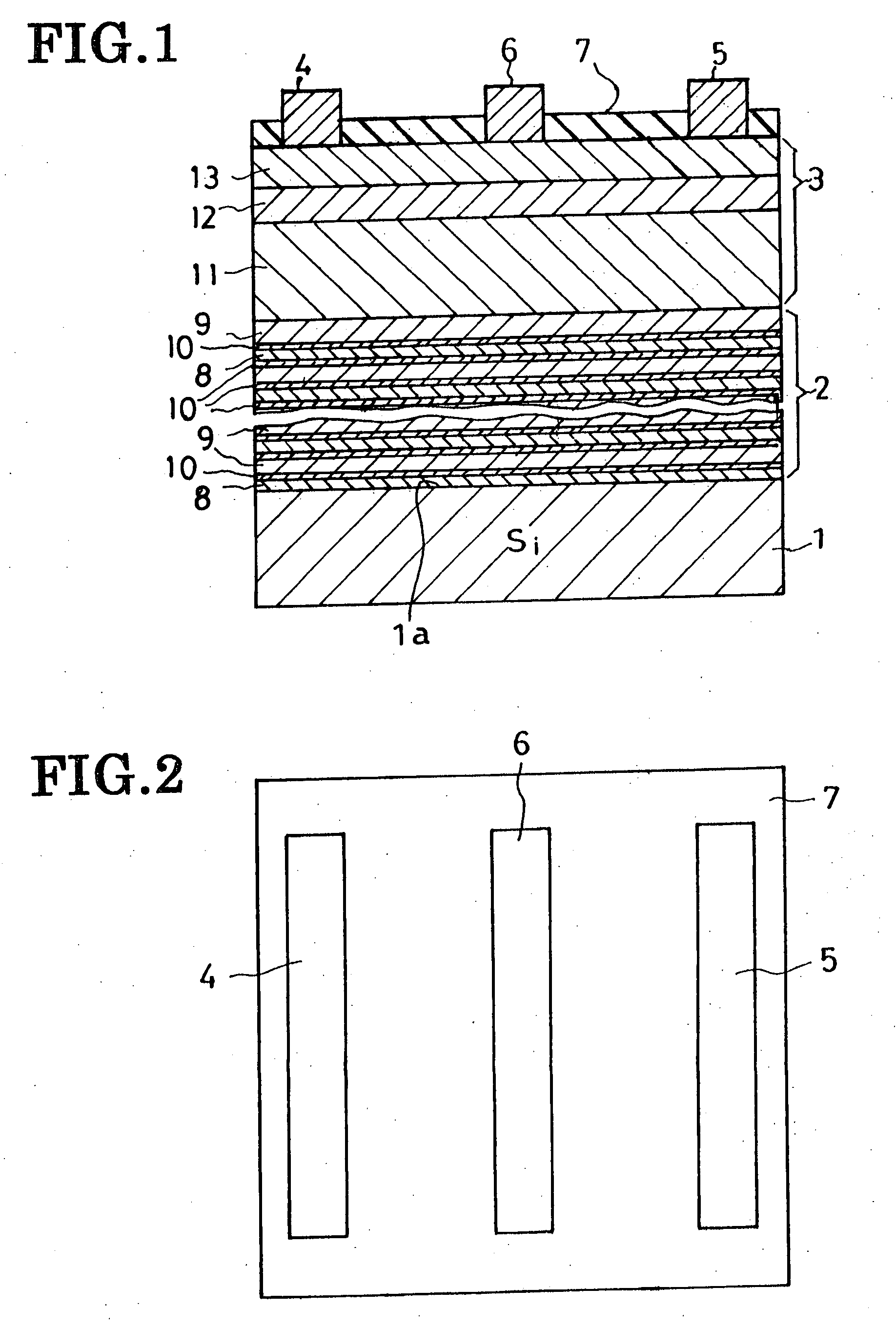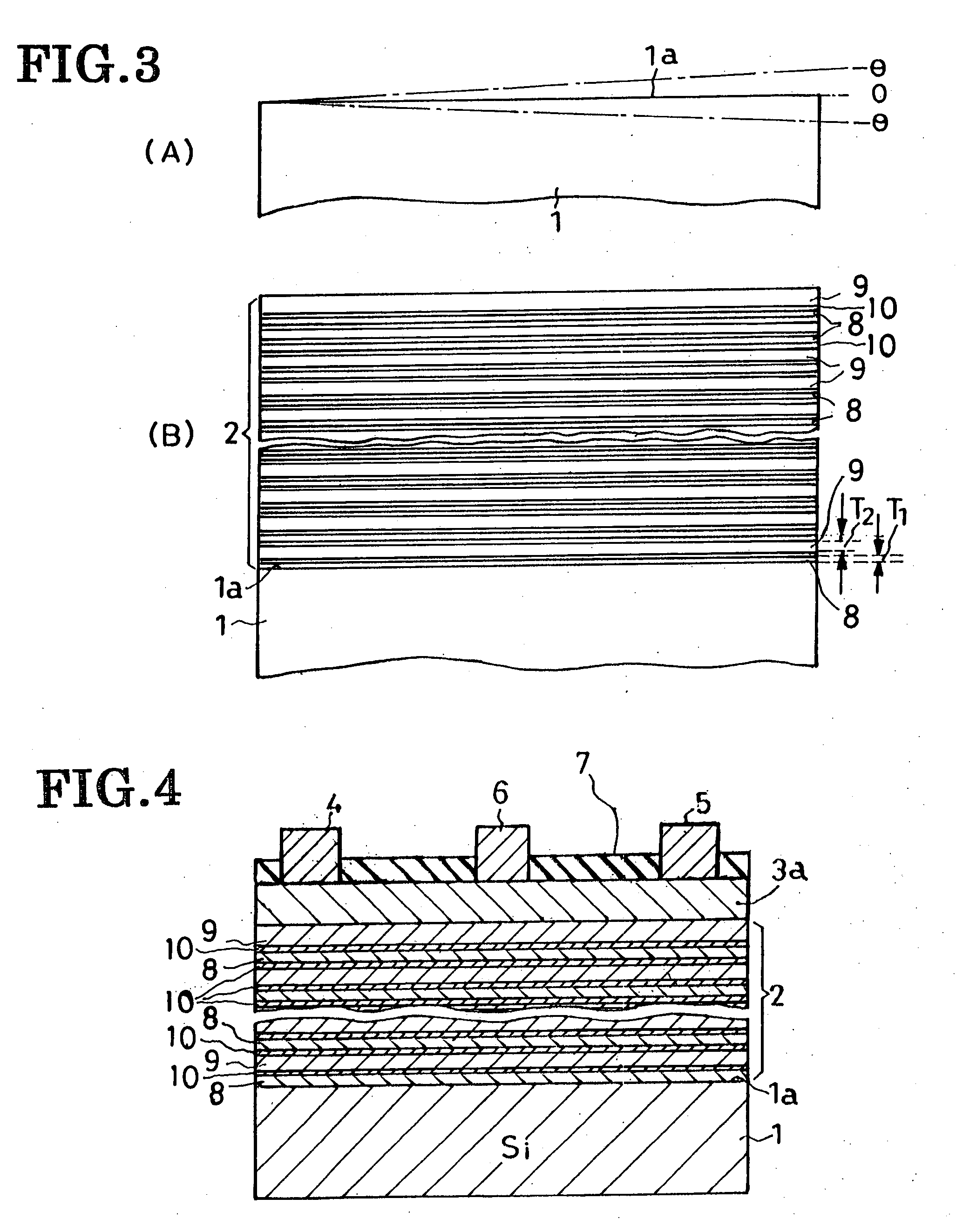Semiconductor device and a method of making the same
a technology of semiconductor devices and buffer sublayers, applied in semiconductor devices, chemical vapor deposition coatings, coatings, etc., can solve the problems of high sapphire cost, added substantively to the manufacturing cost of the semiconductor devices concerned, and difficult and inefficient dicing, etc., to achieve good crystallinity and reduce the strain of the second buffer sublayer
- Summary
- Abstract
- Description
- Claims
- Application Information
AI Technical Summary
Benefits of technology
Problems solved by technology
Method used
Image
Examples
first embodiment
[0064] The invention will now be described in terms of the HEMT using gallium-nitride-based compound semiconductors according to the invention, with reference had to FIGS. 1-3.
[0065] With reference first to FIG. 1 the HEMT embodying the invention comprises a silicon substrate 1, a buffer layer 2, a main semiconductor region 3 constituting the primary working part of the HEMT, a first electrode or source 4, a second electrode or drain 5, a control electrode or gate 6, and an insulating film 7.
[0066] The substrate 1 is a single crystal of p-type silicon containing boron or other Group III element as a conductivity type determinant. The major surface 1a of the substrate 1, on which there is grown the buffer layer 2, is exactly (111) in terms of Miller indices indicative of crystal face orientation. The impurity concentration of the substrate 1 is set as low as, for example, from 1×1012 cm−3 to 1×1014 cm−3 with a view to the reduction of leakage current through the substrate. The resi...
second embodiment
[0117] Reference may be had to FIG. 4 for a study of a MESFET embodying the principles of this invention. Like reference characters denote like parts in both FIGS. 1 and 4, and the description of such like parts will be omitted.
[0118] The MESFET of FIG. 1 is similar to the HEMT of FIG. 1 except that the main semiconductor region 3 of the latter is modified into an n-type semiconductor region 3a in the form of a layer of a GaN compound semiconductor doped with an n-type impurity of silicon. The MESFET has the silicon substrate 1, buffer layer 2, source 4, drain 5, gate 6 and insulating film 7 which are all equivalent to their FIG. 1 counterparts indicated by the same reference numerals. The n-type semiconductor region 3a, which constitutes the primary working part of the MESFET and which might also be termed a channel layer or active layer, overlies the buffer layer 2. Both source 4 and drain 5 make ohmic contact with the n-type semiconductor region 3a whereas the gate 6 makes Schot...
third embodiment
[0121] The buffer layer shown in FIG. 5 and therein generally designated 2a represents a modification of the buffer layer 2 of the two preceding embodiments. The modified buffer layer 2a lends itself to use in both HEMT and MESFET as well as any other semiconductor devices. The modified buffer layer 2a features modified first sublayers 8a, modified second sublayers 9a and unmodified third sublayers 10 of p-type GaN for two-dimensional electron gas. The arrangement of these buffer sublayers 8a, 9a and 10 is the same as that of their counterparts 8-10 in FIGS. 1 and 4.
[0122] The modified first buffer sublayers 8a are made from substances that are generally defined as:
AlxInyGa1-x-yN
where: [0123] 0[0124] 0≦y[0125] x+y≦1.
[0126] No conductivity determinant is added. Examples meeting the above requirements of materials for the modified first buffer sublayers 8a include AlN, AlInN, AlGaN, and AlInGaN. The particular substance employed in this embodiment is Al0.5In0.01Ga0.49N (x=0.5 and...
PUM
| Property | Measurement | Unit |
|---|---|---|
| Time | aaaaa | aaaaa |
| Thickness | aaaaa | aaaaa |
| Angle | aaaaa | aaaaa |
Abstract
Description
Claims
Application Information
 Login to View More
Login to View More - R&D
- Intellectual Property
- Life Sciences
- Materials
- Tech Scout
- Unparalleled Data Quality
- Higher Quality Content
- 60% Fewer Hallucinations
Browse by: Latest US Patents, China's latest patents, Technical Efficacy Thesaurus, Application Domain, Technology Topic, Popular Technical Reports.
© 2025 PatSnap. All rights reserved.Legal|Privacy policy|Modern Slavery Act Transparency Statement|Sitemap|About US| Contact US: help@patsnap.com



